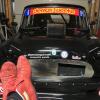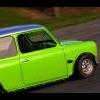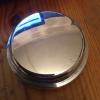Rear Strut Ball Joint
#1

Posted 25 May 2017 - 06:46 PM
Thanks
#2

Posted 25 May 2017 - 06:57 PM
no ball joints on the rear of a Mini.
Knuckle? slip fit.
#3

Posted 25 May 2017 - 06:58 PM
#4

Posted 25 May 2017 - 07:06 PM
No, it should be a tight push fit. If it is not tight, you will get fretting, followed by failure of the alloy trumpet. If it just slips in, either the knuckle was wrongly made or the trumpet is worn or fatigued, and needs to be urgently replaced. To get them out you should need to put a steel rod down the middle of the cone and whack it with a hammer.
The nylon cup should also be very tight in the arm. It is normal to have to put the car on its wheels and bounce it a few times to get everything seated.
Did you check the seating in the arm for damage due to previously worm out knuckle joints?
You did get GENUINE knuckles, not cheap Chinese tat? It really isn't worth it to save a couple of quid.
#5

Posted 25 May 2017 - 07:44 PM
This not meant to sound patronising - apologies if it does but assuming all corrosion free - knuckes are steel and trumpet's alloy so usually some very nice corrosion goes on and renders them very stuck indeed necessitating tiger's freeing solution but if someone took some care last time out and greased everything up nicely then no reason they shouldn't move relatively freely.... should be a tight but smooth fit with no deflection possible when seated - if there is - then replace as appropriate.... they wont come out in use the suspension keeps them seated under tension...
Bet the nylon cup in the radius arm didn't just slip out!!! (they melt very satisfactorily with a blowtorch making removal really easy.... just be careful as grease at high temperature can get nasty)
#6

Posted 25 May 2017 - 07:57 PM
#7

Posted 25 May 2017 - 08:54 PM
#8

Posted 27 May 2017 - 04:51 PM
Well, I hope the used knuckle has adequate life left in it, because if the ball wears through the cup, the arm can be trashed, and other bad things can happen if the knuckle jams and breaks. A new arm is about 50 times the cost of the knuckle. I suggest replacing them every 40k miles as a precautionary measure, but if the rubber has split and dirt got in, they do not last very long.
But it does not say much for the machining tolerances of whoever made your new knuckles. It isn't rocket science to get the correct tight push fit. I have made my views on quality control NOT practised by various Mini suppliers frequently, so I will not bother to do so again.
#9

Posted 27 May 2017 - 07:51 PM
Can't remember where I bought them. The old ones did need a steel rod down the strut and whacking with a hammer. The nylon cups where a right ******* to replace! They took some putting in! Maybe it is just down to cheap knuckle joint.
I've found some of the after market ones to be a few thousands over-size. I like to have the stem on the ball an easy slip fit in to the trumpet (or hilo). I always grease the stem too, to reduce corrosion (or rust in the case of hilos).
The nylon cups go in very easy if you clean the socket in the arm first. I just use a small wire wheel on the drill for this, then once again, I grease the nylon cup (on the outside) to aid it's fitting and also to stop rust. I then find if replacing again later, the cup slips out easy with the fingers.
Also, before fitting them, check how much grease is in the cup, they often have little more than a smear.
#10

Posted 28 May 2017 - 01:53 PM
Then there is the question of what grease to use. It was originally "Shell Dextragrease Super GP", but Google only turns up references to Rover manuals and people looking for it. There seems to be no published info on the now obsolete grease. Last time I needed to clean and refill them, I just used LM, but I was not too happy about it. I have done a lot of research into lubricating plastics, including nylon, and found nothing conclusive, or even remotely helpful, anywhere. (I did find some info that suggested using PEEK to make the cups, which should last very much longer than nylon, but then I checked the cost of PEEK...) The original grease was red, and the name may (or may not) suggest that it involves dextrose, one of the sugar family, as its base. It definitely bears no relation to red brake grease, as it has to carry high loads rather than keep out water. However, I am wondering if this stuff would be useful:
https://lucasoil.com...-n-tacky-grease
At least the colour is right, for the benefit of the most extreme purists. I have seen that same stuff used (wrongly, as I think we agree!) in steering racks.
Oh,, and apologies for not mentioning it earlier, the slightly easier way of fitting the cups to the arms, which I had almost forgotten, is to take a hot soldering iron and basically melt a shallow groove down the side of the cup, then with a sharp blade trim off any raised material. You now have a path to allow air to escape from under the cup, which helps. Don't overdo it, a groove that you can feel with your fingernail is all that you need. 10 thou deep, or so. They are still usually rather tight, which does no harm at all.
Very early arms reputedly had a very small vent hole drilled in the back to allow air out. The fact that it was definitely not there on any Mini post 1970 that I have owned suggests that it was dropped early in production. I wonder if it was a stress raiser, and initiated fractures? A rough, badly drilled hole can do that, and there is an amazingly high peak load on the area, but there are simple techniques to prevent it. Or maybe BMC were just too mean to drill the holes any more?
#11

Posted 28 May 2017 - 02:44 PM
#12

Posted 28 May 2017 - 02:58 PM
Without them the cup doesn't seat easily/properly as it creates an airlock behind it.
#13

Posted 28 May 2017 - 03:18 PM
Curious! So maybe removing the holes was a mistake, and they were reinstated later?
Someone published a fairly expensive book late last year which documented all the changes over the years. I saw it reviewed in a magazine somewhere, but can't find any mention of it anywhere now, or what it was called. If I ever find it, I may buy a copy, as it should tell of this and many other minor modifications.
Edit: I was answering Dusky, but as GraemeC has now added some more, I will just confirm that my 1970 or thereabouts and 1984 models did not have the holes, which is why I tried the soldering iron trick successfully. I was aware that holes "should" have been there, and did scrape the area clean for a good look.
So now I am thinking that manufacture and quality control were sloppy and they were supposed to be drilled, but were forgotten.
Second edit: I will report back if and when I get the chance to examine some more Minis. I am expecting to be buying one this year. I will be delighted if I do find the holes!
Edited by tiger99, 28 May 2017 - 03:25 PM.
#14

Posted 28 May 2017 - 04:31 PM
#15

Posted 28 May 2017 - 06:37 PM
Can't remember where I bought them. The old ones did need a steel rod down the strut and whacking with a hammer. The nylon cups where a right ******* to replace! They took some putting in! Maybe it is just down to cheap knuckle joint.
I've found some of the after market ones to be a few thousands over-size. I like to have the stem on the ball an easy slip fit in to the trumpet (or hilo). I always grease the stem too, to reduce corrosion (or rust in the case of hilos).
The nylon cups go in very easy if you clean the socket in the arm first. I just use a small wire wheel on the drill for this, then once again, I grease the nylon cup (on the outside) to aid it's fitting and also to stop rust. I then find if replacing again later, the cup slips out easy with the fingers.
Also, before fitting them, check how much grease is in the cup, they often have little more than a smear.
A few thousandths oversize ? how do you know ? I know you haven't got the drawing for this part as you would know that the tolerance is greater than a few thou !
1 user(s) are reading this topic
0 members, 1 guests, 0 anonymous users



















